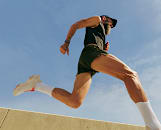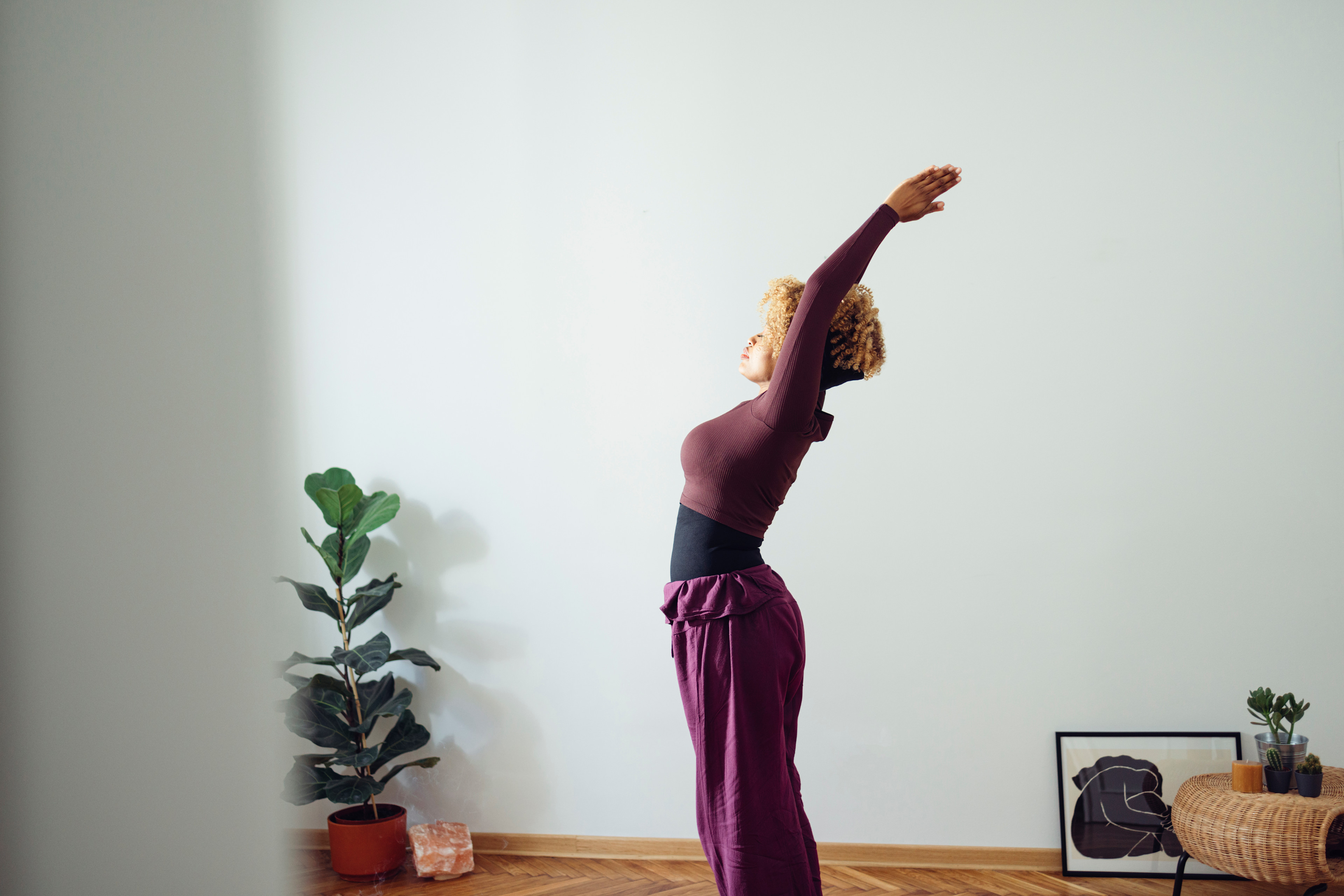
Miniseries via Getty Images
10 Morning Stretches That Feel Like a Fresh Start
Add a little tension release to your AM, and change the way you feel all day long.
By Michelle Konstantinovsky•
The Benefits of Stretching In the Morning
10 Morning Stretches to Start Your Day
How to Make a Morning Stretch Routine
The Takeaway
Along with logging enough sleep and flossing after meals, maintaining a morning stretch routine may be one of those healthy habits you let fall by the wayside. While it’s simple enough to press “play” on a post-workout stretch class as soon as you wrap up a strength session or hop off the Bike, Tread, or Row, it takes a little extra dedication to get limber first thing in the morning. But morning stretches can make a major difference in your energy, mood, and ability to comfortably move your body all day, so it’s worth adding them to your list of beneficial to-dos (along with adequate rest, dental hygiene, and all those other good-for-you behaviors).
Discover more ways to reach your goals with Peloton
Here’s why morning stretches can be game-changing, and how to incorporate 10 specific ones into your daily routine.

Peloton App
Access thousands of classes with no equipment needed.
The Benefits of Stretching In the Morning
Believe it or not, morning stretches are a matter of instinct; they help prime the body and brain for the day ahead. The stretches most of us naturally do upon waking are helpful for getting your circulation going after a long night of decreased movement, but scheduling an intentional stretch session can be beneficial for several reasons, including:
Improved muscle flexibility and activation
Better blood flow to the joints and muscles
Reduced stress
Enhanced coordination and balance
Improved athletic performance
Decreased risk of injury
“Who doesn't like getting the kinks out?” says Peloton instructor Hannah Corbin, author of the forthcoming book Did You Stretch Tho: 52 Stretches to Increase Flexibility, Balance, and Performance. “Whether from working out or a stressful day, the body might wake up with some unexpected soreness and stiffness, and it’s an excellent compensator—it will find a way to move forward even when that stiffness and soreness are standing in its way.”
While your body may be great at figuring out how to function in spite of aches, pains, and tightness, it can’t perform optimally without a little TLC in the form of a morning stretch. “The best part of stretching in the morning is getting ahead of that need to compensate,” Hannah says. “What if five to 10 minutes of gentle morning stretches could stop a full day of thinking about that nagging tightness in your lower back or that annoying ache in your calves?”
Tanya Goodrich, a physical therapist and founder of Healthy Pelvis Physical Therapy, agrees that one of the primary arguments for morning stretching is to release stiffness that accumulated overnight. “Both muscles and joints tighten during sleep; stretching restores movement, circulation, and comfort,” Goodrich says. “Morning stretches also improve our alignment by resetting joint positioning and muscle balance, which helps prevent strain during daily activities.”
Stretching in the morning is also a key way to get your body prepped for the activities of the day, thanks to the positive impact of gentle exercise on synovial fluid, the substance that lubricates and cushions the joints. “Early movement lubricates joints via synovial fluid and primes the muscles for better posture and injury prevention,” Goodrich says. “When we’re young, we don’t really have to think about lubricating our joints and we move a lot, but as we get older, we don’t move as much and we don’t make as much synovial fluid, which is like nutrients for the joint.”
But morning stretches aren’t just about optimizing your physical performance: Your brain benefits too. “Stretching in the morning activates the nervous system by waking up the muscles, joints, and the brain-body connection, which can boost your energy,” Goodrich says. “It also impacts your mental well-being—stretching lowers cortisol, releases endorphins, and sets a calm, focused tone for the day.”
10 Morning Stretches to Start Your Day
You don’t necessarily need to carve out a ton of time to fit in your morning stretches. Try incorporating these 10 moves into your routine before (or while!) you brew your coffee, check emails, or get mentally prepared for the day ahead. If you’d rather follow along with a guided stretch, try an instructor-led stretching class on the Peloton App.
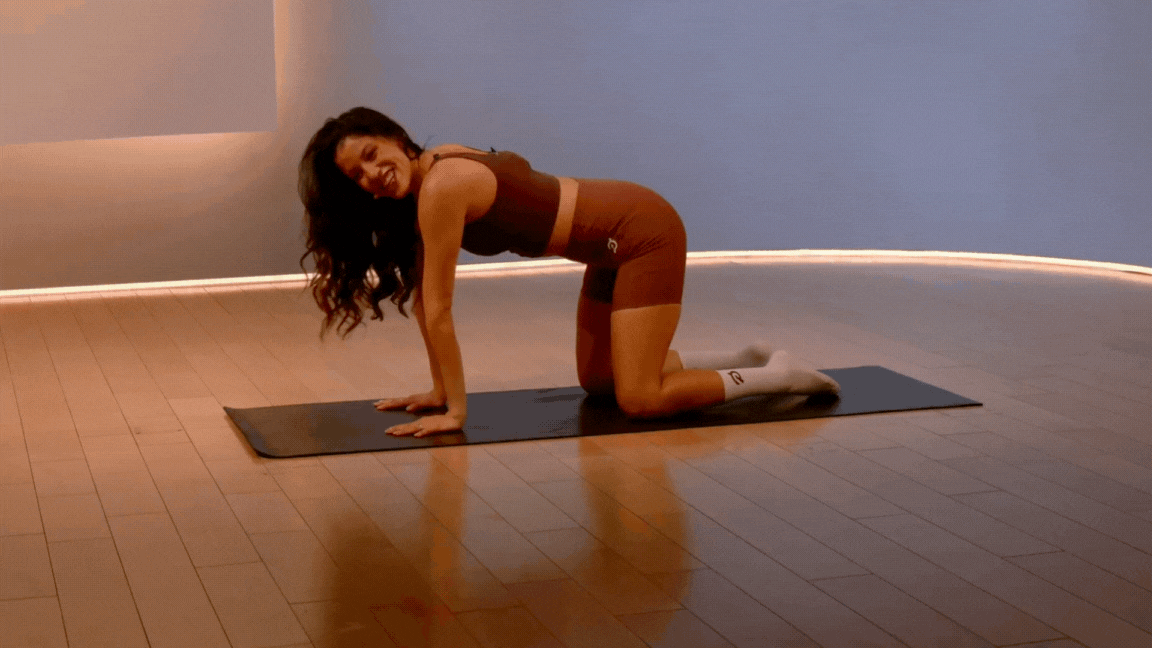
1. Thread the Needle Stretch
The thread the needle stretch is a crowd favorite, thanks to its ability to release upper body tension. “Be gentle, but lean into the discomfort,” Hannah says.
Start on the floor on your hands and knees.
From all fours, thread your right arm underneath your torso so your right shoulder rests on the floor. Rotate your chest open to the left and up to the ceiling, if your mobility allows.
Hold at least 30 seconds, then repeat on the other side.
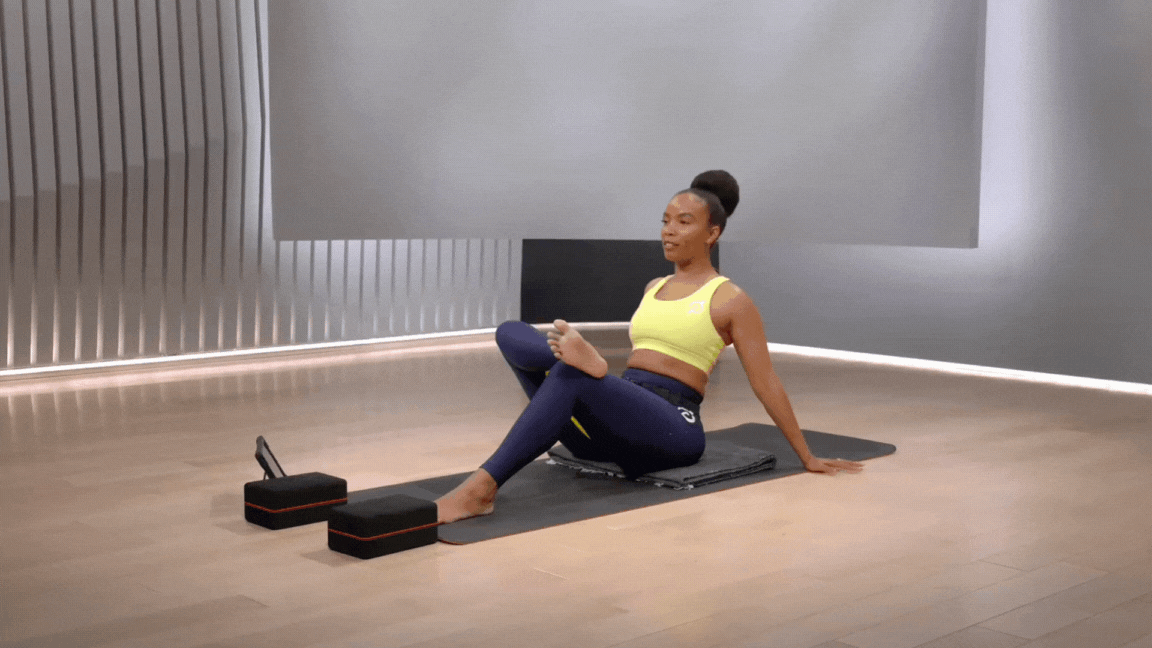
2. Seated Figure 4
Not only is a seated figure 4 stretch a great way to open the hips, but it can also stretch the glutes and inner thighs while releasing any built-up tension in your back. “Once you feel the stretch across the side and back of your hip, gently rock the legs side to side to zhuzh,” Hannah says. If this version of the stretch is too intense for you, you can also perform it supine (i.e., lying on your back).
Start sitting on the floor with your legs extended in front of you and hands on the floor behind your hips.
Bring your right ankle to rest just above the opposite knee, bending your right knee and allowing it to open up to the side.
Leaning back into your hands, bend your left knee and scoot your left foot closer to your hips until the sole of your left foot is flat on the floor. You should feel a stretch in the outside of your right hip. If this feels good, try gently rocking your legs side to side.
Hold for a minute, then repeat on the other side.
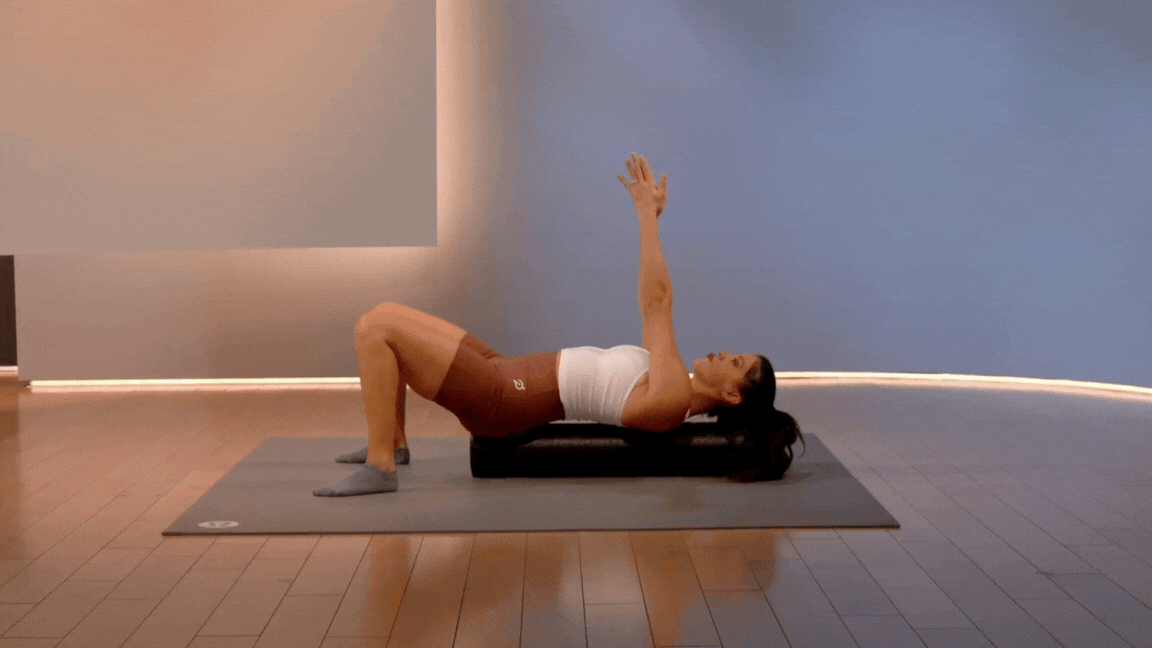
3. Foam Roller Chest Expansion
Grab a foam roller (preferably a long one) for this stretch. “If you know me, you know how much I love this passive stretch that uses the foam roller as a prop!” Hannah says. “With each breath, allow gravity to do its thing.”
Sit on the very end of the foam roller. Lay your torso back so your head and back are resting on it. “The buns will barely be on the roller at this point,” Hannah says.
Keeping your feet wide and eyes open for balance, bring both arms out into a “T” position with the palms toward the ceiling (it’s okay if your elbows have a slight bend and/or if the hands are hovering). Hold for 1-2 minutes.
4. Ankle Rolls
Goodrich loves doing a few morning ankle rolls to lubricate the joints and pump some blood back into the lower legs after a long night. “If you need to hold onto something while you do it, you absolutely can,” Goodrich says. “You can also gently rest your toes on the floor and roll the ankle from there.”
Balance on your left leg with your knee slightly bent, your right foot hovering off the floor.
Slowly rotate the right foot in a circular motion, first to the left, then to the right. Focus on performing the motion with your foot and ankle instead of using your entire leg.
You can also gently rest the toes of the right foot on the floor and rotate the ankle from that position.
Continue for about 30 seconds, then repeat on the other side.
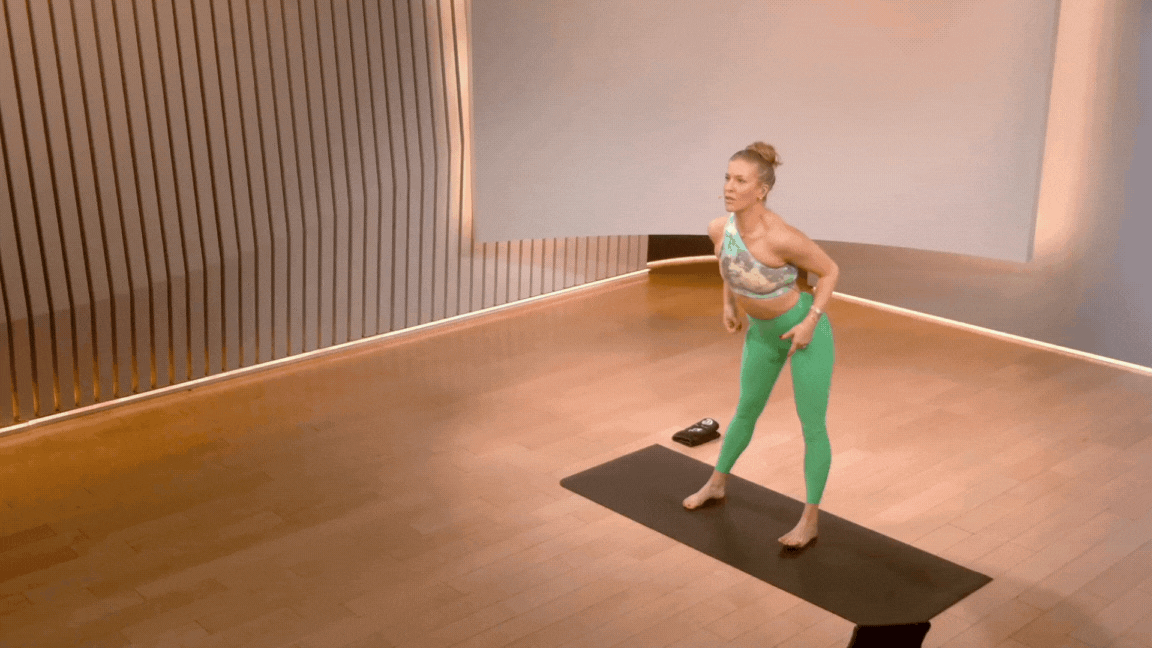
5. Hip Circles
Many of us might wake up with stiffness in our hips, and a powerful antidote, according to Goodrich, is adding a few hip circles first thing in the morning. “I’m famous for my hip circles,” she says. “They’re such an easy way to get good movement through the pelvis and low back.” Avoid doing large sways—imagine your hips are steering a poon that’s stirring a pot of soup. “It’s a really great image because it gets you to do big and juicy movements to really get the full sides of the pot.”
Stand up straight with your feet a little wider than shoulder-width distance apart and your knees slightly bent.
Slowly roll your hips in one direction, imagining you’re drawing circles with your pelvis. Rather than shifting your weight from side to side, think about tilting your pelvis as you roll your hips.
Continue for 30 seconds, then repeat going in the opposite direction.
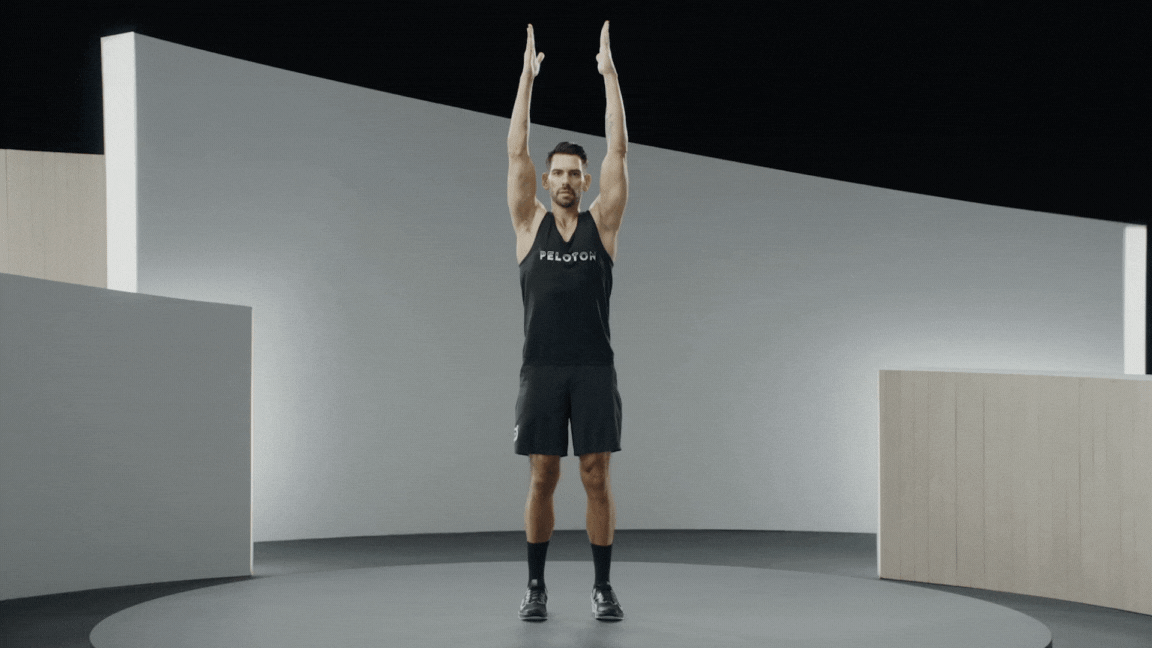
6. Standing Side Bend
No matter which position(s) you sleep in, you might find your side body feeling a little crunched and tender in the mornings. To gain some length back in your sides, try doing this stretch to open up your rib cage and get your spine moving again. To maximize the benefits, Goodrich recommends focusing your breath on the intercostal muscles (between your ribs), obliques, and lats. “You’re not moving just from your shoulder—you really want to move from your rib cage,” she says.
Start by standing up straight, knees slightly bent, and feet a little wider than hip-width distance apart.
Reach your hands overhead (optional: clasp your hands together).
Inhale, squeezing your glutes and pressing your feet into the ground. Exhale while you arch up and over to one side with your arms, stretching your side body.
Hold for 30 seconds, remembering to breathe. On an inhale, bring your upper body back to the starting position and repeat on the other side.
7. Dynamic Lunges
Rather than holding a static lunge, Goodrich recommends moving through a series of alternating forward lunges to boost early morning mobility and build strength. “If you want to be able to get up and down off the floor without using your hands, you really need to have strong quads and you need mobility through your hips,” she says.
Start standing position with your feet hip-width distance apart.
Take a big step forward with the right foot. Bend both knees, keeping the front knee in line with the toes and the back knee hovering just off the floor.
Step back to the starting position.
Repeat on the other side. Continue alternating for 30-60 seconds.
8. Standing Cat Cow
While Cat Cow is traditionally performed from a tabletop position on the floor, Goodrich recommends doing a standing variation in the mornings to help mobilize the spine in a different position and keep your routine more accessible if you’re short on time.
Start standing with your feet hip-width distance apart, knees softly bent. Hinge at the hips to bend forward, gently resting your hands on your upper thighs.
On an inhale, arch your lower back and lift your head up while tilting your pelvis forward.
On an exhale, contract your core in and round your spine, bringing your chin toward your chest and tilting your pelvis under.
Repeat for 30-60 seconds.
9. Shoulder Dips
Goodrich is a fan of shoulder dips in the morning because they help stretch both the rib cage and the groin. “If you have to stay a bit higher up on your thighs and don’t have as much mobility in your spine, that’s OK,” she says. “You’ll still get an amazing inner thigh and rib cage stretch.”
Start standing with your feet shoulder-width distance apart, knees softly bent. Hinge at the hips to bend forward, gently resting your hands on your upper thighs.
Begin by dipping one shoulder forward so you feel a gentle stretch, then repeat on the other side. Repeat for 30-60 seconds.
10. Spinal Twisting
“This move is very meditative and therapeutic and you’ll often notice children doing it,” Goodrich says. “The idea is to really use momentum to turn your body. You’ll get a beautiful rotation of the entire spine. This is great to do in the morning when you first wake up and you’re feeling stiff—I like to do this while my coffee is brewing in the morning.”
Start standing with your feet hip-width distance apart and knees slightly bent.
Begin to gently rotate your spine so you face one side of the room and then the other, twisting from the waist while keeping your arms relaxed.
Continue to relax your arms completely as you twist from side to side, allowing them to gently brush the tops of your thighs as you twist.
Continue for about 30 seconds.
Try a Stretching or Mobility Class on the Peloton App
How to Make a Morning Stretch Routine
Like all new habits, it can take a while to find your groove and solidify a regular morning stretch routine. Here are some tips to help you integrate the practice into your day-to-day:
Find your why. “Be better than your best excuse,” Hannah says. “We can all come up with a million reasons why we don’t ‘have time’ for something, but in truth, we make time for the things and people that we want to make time for.”
Put it in your calendar. “Schedule 5-10 minutes on Mondays, Wednesdays, and Fridays and make it a ‘non-negotiable’ in your mind, versus an option,” Hannah says. “Pretty soon, it will become a habit that you can’t live without.”
Go guided. To eliminate any extra thinking in the AM, cue up a guided stretching session, like a Full Body Stretch or Morning Mobility class on the Peloton App. That way, all you need to do is listen and follow along—no need to plan out stretches or watch the clock.
Try habit stacking. Pairing morning stretches with something that’s already part of your routine—like making coffee or brushing your teeth—can help your morning stretch habit become automatic rather than something that relies on willpower alone.
Keep coming back. To really solidify morning stretches as an automatic habit, it’s also important to practice patience and commit to doing it regularly if you want to see results. “Remember that flexibility and mobility take time to build and work to maintain,” Hannah says.
The Takeaway
A morning stretch routine is one of those oh-so-good-for-you habits that may slip when life gets in the way, but it’s so worth maintaining. In addition to helping you improve your muscle flexibility, morning stretches can increase blood flow, enhance your coordination, decrease your risk of injury, and even reduce stress. And if you have a solid workout routine already, you can even count on morning stretches to improve your athletic performance.
Dedicating just 30-60 seconds to each stretch above can go a long way in optimizing your physical and mental health for the whole day—and you don’t even have to change out of your pajamas.
Related Articles

Stretching + Mobility
Can You Stretch Your Way to Bigger Muscles? Here’s What Experts Say

Stretching + Mobility
These Are The Two Key Times Everyone Should Be Stretching

Stretching + Mobility
Yes, You Can Stretch Too Much—Here Are Signs You Might Be Overdoing It

Stretching + Mobility
Why You Should Care About Ankle Mobility—Plus 7 Exercises to Try
This content is for informational and educational purposes only and does not constitute individualized advice. It is not intended to replace professional medical evaluation, diagnosis, or treatment. Seek the advice of your physician for questions you may have regarding your health or a medical condition. If you are having a medical emergency, call your physician or 911 immediately.
Level up your inbox.
Subscribe for a weekly dose of fitness, plus the latest promos, launches, and events.
By providing your email address, you agree to receive marketing communications from Peloton.
For more about how we use your information, see our Privacy Policy.

